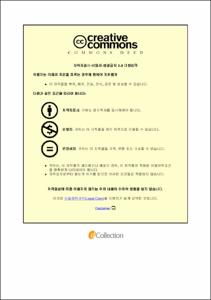사용자 경험 디자인 관점에서 본 전통시장 ICT 카페 활성화 방안에 관한 연구
- Alternative Title
- A Study on the Activation Plan of ICT Café in Traditional Market from User Experience Design Perspective
- Abstract
- Modern design trend keywords can be selected by two factors as 'user' and 'service'. Also, the subject of design has changed from technology, function, product, space to user focus, and user's viewpoint has also changed to user with desire and leading judgment criteria. In this study, we tried to overcome the limitation of the facility modernization project and proceeded with the 'ICT Traditional Market Promotion Project' among various support projects with a new direction focusing on customer - centered service design development. However, according to the '2017 ICT Traditional Market setup check' by the Ministry of Ministry of SMEs and Startups, Overall poor phenomenon such as number of verifiers, management and management, location accessibility, space and system availability are served. The purpose of this study is to identify the elements, characteristics, and spatial areas of user experience design and analyze the current situation of ICT cafes to elicit specific services and strategies for activating ICT cafes and to present practical plans. First of all, the experience elements and characteristics of the service aspect appearing in the space are examined through various understanding of user experience design. In addition, the understanding and status of ICT cafes in traditional markets and spatial analysis were conducted, and the characteristics of user experience-oriented designs were derived to derive the characteristics of ICT cafes centered on the type of user's area. Next, based on the criteria of the case study sites, we set up the analysis framework through the observation survey of the study sites, conducted the case studies, and conducted the comprehensive survey and evaluation analysis results and surveys. Finally, I suggested a plan to revitalize ICT cafe space from the viewpoint of comprehensive analysis and user experience - oriented design. As a result, user experience design paradigm has experience point of view, behavior, motivation improvement, user experience design factor in space is derived as Space, User, Mediation. And user experience design correlations in Space-User-Mediation are derived from sensibility, cognition, associativity, dynamics, and interactivity. Next, the problems of ICT cafes were understood through understanding of traditional ICT cafes, and the method of analyzing the ICT cafes themselves was determined by analyzing the characteristics of public users and the public users of ICT cafes. As a result of analyzing case studies and surveys, we were able to derive three directions of basic improvement of traditional market ICT cafes. In this study, based on the case analysis, we suggested 6 ways to improve ICT cafe service design in traditional market. This study proposed enhancement of customer convenience of ICT cafe in traditional market and application of user experience design so that users can focus on practical help and experience. Also, it is meaningful to propose 'ICT Traditional Market Promotion Project' as a continuous business rather than a one-time project through the previous research analysis method, and to provide various experiences such as convenience and information acquisition to visitors and traders using the traditional market.
- Issued Date
- 2019
- Awarded Date
- 2019. 2
- Type
- Dissertation
- Keyword
- User Experience Design ICT Cafe
- Publisher
- 부경대학교
- Alternative Author(s)
- Kang Eun Gyeong
- Affiliation
- 부경대학교 대학원
- Department
- 대학원 마린융합디자인협동과정
- Advisor
- 조정형
- Table Of Contents
- Ⅰ. 서론 1
1. 연구의 배경 및 목적 1
2. 연구의 방법 및 범위 2
3. 연구 진행 구성도 5
Ⅱ. 사용자 경험 디자인 이론적 고찰 6
1. 사용자 경험 디자인 개념 6
2. 사용자 조사의 이해 및 방법 7
가. 사용자 조사의 이해 7
나. 사용자 조사 방법 9
3. 사용자 경험 디자인과 공공 공간의 상관관계 14
가. 경험 디자인이란? 14
나. 공공공간 디자인이란? 16
다. 공간에서의 사용자 경험 디자인 요소 16
4. 공간-사용자-매개의 사용자 경험 디자인 특성 21
5. 소결 24
Ⅲ. 전통시장 ICT 카페의 이해 25
1. 전통시장의 이론적 고찰 25
가. 전통시장의 개념 25
나. 전통시장의 발전 요인 26
다. 전통시장의 새로운 변화 28
2. ICT와 ICT 카페의 이해 29
가. ICT의 개념 29
나. ICT 카페의 이해 30
3. ICT 카페의 현황 및 문제점 32
4. 전통시장 ICT 카페의 사용자 접점 공간 33
5. 사용자 중심에 따른 ICT 카페의 영역 요소 35
가. ICT 카페 공공 공간의 영역성 35
나. 사용자 중심에 따른 공공 영역 특성 36
6. 소결 40
Ⅳ. 사례 분석 41
1. 연구 대상지 선정 41
2. 대상지 분석 방법 42
3. 사례 분석 방법 43
4. 사례 분석의 틀 44
5. 사례 분석 45
가. 서울 용문종합시장 45
나. 서울 명일시장 47
다. 서울 방이시장 49
라. 서울 풍납시장 51
마. 서울 까치산시장 53
바. 의정부 제일시장 55
사. 부천 원미종합시장 57
아. 수원 정자시장 59
자. 부산 동래시장 61
차. 부산 기장시장 63
카. 제주 동문시장 65
6. 분석 결과 67
7. 설문 조사 71
Ⅴ. 사용자 경험 디자인에 따른 전통시장 ICT 카페 개선방안 77
1. 전통시장 ICT 카페 기본개선 방향 77
2. 전통시장 ICT 카페 디자인 개선 방안 78
Ⅵ. 결론 81
감사문 84
참고문헌 85
부록 88
- Degree
- Master
- Appears in Collections:
- 대학원 > 마린융합디자인협동과정
- Files in This Item:
-
-
Download
 사용자 경험 디자인 관점에서 본 전통시장 ICT 카페 활성화 방안에 관한 연구.pdf
기타 데이터 / 2.47 MB / Adobe PDF
사용자 경험 디자인 관점에서 본 전통시장 ICT 카페 활성화 방안에 관한 연구.pdf
기타 데이터 / 2.47 MB / Adobe PDF
-
Items in Repository are protected by copyright, with all rights reserved, unless otherwise indicated.